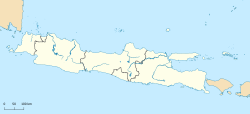
Back Kediri (regentskap) Afrikaans منطقة وصاية كديري Arabic Kabupatén Kediri BAN Kediri Kabupatèn BEW Kabupaten Kediri CEB Kediri (Regierungsbezirk) German Kabupaten Kediri GOR Kabupaten Kediri ID Reggenza di Kediri Italian Kabupatèn Kadhiri JV
Kediri Regency
Kabupaten Kediri | |
|---|---|
| Other transcription(s) | |
| • Javanese | ꦏꦧꦸꦥꦠꦺꦤ꧀ꦏꦣꦶꦫꦶ |
Clockwise, from top left : View of Mount Wilis and the Brantas River at Kediri, Surowono Temple, Simpang Lima Gumul Monument | |
| Motto(s): Canda Bhirawa (forming the gallantry by the bond of unity) | |
 Location within East Java | |
| Coordinates: 7°50′00″S 112°10′00″E / 7.8333°S 112.1667°E | |
| Country | |
| Province | East Java |
| Capital | Ngasem |
| Government | |
| • Regent | Hanindhito Himawan Pramono |
| Area | |
• Total | 1,563.42 km2 (603.64 sq mi) |
| Population (mid 2023 estimate)[1] | |
• Total | 1,684,454 |
| • Density | 1,100/km2 (2,800/sq mi) |
| Time zone | UTC+7 (IWST) |
| Area code | (+62) 354 |
| Website | kedirikab.go.id |
Kediri Regency (Javanese: ꦏꦧꦸꦥꦠꦺꦤ꧀ꦏꦣꦶꦫꦶ) is a regency (kabupaten) located in East Java province, Indonesia. It is one of two 'Daerah Tingkat II' that has the name 'Kediri' (the other is the City of Kediri, which is separate from the Regency). The Regency covers an area of 1,563.42 km2 and had a population of 1,499,768 as of the 2010 census[2] and 1,635,294 at the 2020 census;[3] the official estimate as at mid 2023 was 1,684,454 (comprising 849,958 males and 834,496 females).[1]
The capital of the regency is in the town of Ngasem, which is effectively a northern suburb of Kediri city, just about 200 metres over the municipal border. However, several regency government establishments are also located within Kediri city, although it is administratively a separate political entity. This is because both the regency and the city share common cultural and historical roots, and the administrative division occurred only after the War of Independence. The regency shares borders with Jombang Regency to the north, Malang Regency to the east, Blitar Regency and Tulungagung Regency to the south, and Nganjuk Regency to the west, while Kediri city is wholly surrounded within the Regency. Kelud mountain, one of the most active volcanoes in Indonesia, is partially administered by the Government of Kediri Regency (along with Blitar Regency).
The regency also contains the famed "Kampung Inggris", or English Village. Kampung Inggris is a small area in the district of Pare where over a hundred businesses offering various English courses are clustered. Students come from all over Indonesia to take courses in the English Village, where it is common for people to speak with each other in English (rather than Indonesian or Javanese) for the sake of practice.





